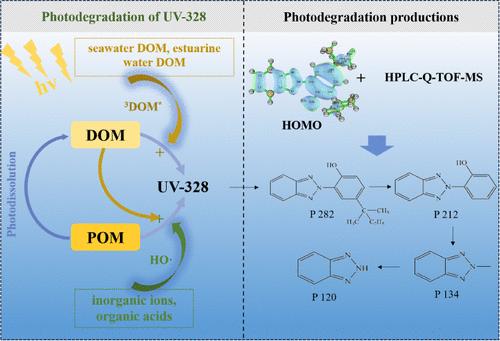模拟太阳照射下天然有机物环境中UV-328的光降解机理
IF 11.3
1区 环境科学与生态学
Q1 ENGINEERING, ENVIRONMENTAL
引用次数: 0
摘要
2-(苯并三唑-2-基)-4,6-双(2-甲基丁烷-2-基)苯酚(UV-328)是一种广泛应用于塑料和各种产品的紫外线吸收剂,在环境中经常被检测到;然而,对其光化学降解的研究却很少。溶解性有机物(DOM)和颗粒性有机物(POM)是天然有机物的重要组成部分,它们通过吸收光子产生光敏效应。本研究考察了不同来源的DOM对模拟日光条件下UV-328光降解的影响。实验表明,激发三重态DOM (3DOM*)是促进UV-328光降解的主要因素。利用激发发射矩阵光谱结合平行因子分析(EEMs-PARAFAC)和海水超滤实验,证明了高分子量DOM,特别是海水中产生的本地DOM,可以更快地光降解UV-328。另外,悬浮颗粒物(SPM)中UV-328的光降解受DOM、无机离子和有机酸的影响,DOM对降解过程起到正反馈作用。采用超高效液相色谱-四极杆飞行时间质谱法(UPLC-Q-TOF-MS),并辅以密度泛函理论(DFT)计算,首次阐明了UV-328的降解途径和产物。本研究首次将DOM和POM结合在一起,为UV-328的光降解机制提供了新的见解。本文章由计算机程序翻译,如有差异,请以英文原文为准。

Photodegradation Mechanism of UV-328 in Natural Organic Matter Contexts Under Simulated Solar Irradiation
2-(Benzotriazol-2-yl)-4,6-bis(2-methylbutan-2-yl)phenol (UV-328), a widely utilized UV absorber in plastics and diverse products, has been frequently detected in the environment; yet, research on its photochemical degradation is scarce. Dissolved organic matter (DOM) and particulate organic matter (POM), as important components of natural organic matter, can produce photosensitization by absorbing photons. This study examined the influence of DOM from various sources on the photodegradation of UV-328 under simulated daylight conditions. Experiments revealed that excited triplet DOM (3DOM*) is the primary factor enhancing the photodegradation of UV-328. Utilizing excitation–emission matrix spectroscopy combined with parallel factor analysis (EEMs-PARAFAC) and seawater ultrafiltration experiments, it was demonstrated that high molecular weight DOM, particularly autochthonous DOM produced in seawater, could more rapidly photodegrade UV-328. Additionally, the photodegradation of UV-328 in suspended particulate matter (SPM) was influenced by DOM, inorganic ions, and organic acids, with DOM contributing to a positive feedback effect on the degradation process. The degradation pathways and products of UV-328 were first elucidated using ultraperformance liquid chromatography-quadrupole time-of-flight mass spectrometry (UPLC-Q-TOF-MS), supplemented by density functional theory (DFT) calculations. This study provides novel insights into the photodegradation mechanisms of UV-328 by combining DOM and POM for the first time.
求助全文
通过发布文献求助,成功后即可免费获取论文全文。
去求助
来源期刊

环境科学与技术
环境科学-工程:环境
CiteScore
17.50
自引率
9.60%
发文量
12359
审稿时长
2.8 months
期刊介绍:
Environmental Science & Technology (ES&T) is a co-sponsored academic and technical magazine by the Hubei Provincial Environmental Protection Bureau and the Hubei Provincial Academy of Environmental Sciences.
Environmental Science & Technology (ES&T) holds the status of Chinese core journals, scientific papers source journals of China, Chinese Science Citation Database source journals, and Chinese Academic Journal Comprehensive Evaluation Database source journals. This publication focuses on the academic field of environmental protection, featuring articles related to environmental protection and technical advancements.
 求助内容:
求助内容: 应助结果提醒方式:
应助结果提醒方式:


